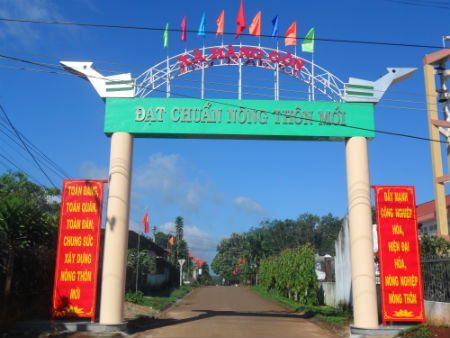1. LABOR RESOURCES
The total number of households in Hang Gon: 2,845
The number of residents: 11,811
The number of people at their working age: 7,087
+ The rate of industrial laborers: 9.36%
+ Rate of agricultural laborers: 48.64%
+ The rate of commercial laborers: 22.03%
+ The rate of service laborers: 19.97%
2. LAND
Total natural land area: 3,385. 31 ha.
Agricultural land area: 2,121.29 ha – 62.6%.
Forest land area: 41.47 ha - 1.2%.
Special-use land area: 266.14 ha - 7.8%.
Housing land area: 951.15 ha - 28.09%.
Land use: The commune’s land is relatively favorable
for agricultural production and planting perennial crops and climate is also
quite favorable for planting annual and perennial crops, especially fruit trees.

3. FOREST RESOURCES
Forest area: 49.2 ha.
Types of forest trees.
Most of the forest area is planted with weeping
paperbark, African mahogany, Hopea odorata, Afzelia xylocarpa, and other types.
Economic efficiency: forests provide sources of wood
and firewood, are natural air-conditioners, prevent storms, and regulate water
and are also a habitat for plants and animals as well as a place for storing
valuable and rare genetic resources.
4. MINERAL RESOURCES
Hang Gon has basaltic soil which is favorable for
developing industrial crops, especially such fruit trees as durians, rambutans,
mangosteens, and so on.
There are mineral mining sites in Hang Gon like the
peat in Cau Dau lake and the exploiting material site for leveling hill 64.
There are Cau Dau and Bau Mon reservoirs in Hang Gon,
which are the places storing underground water sources and helping to develop
the eco-tourism in the future.
5. LANDSCAPES, TOURIST
ATTRACTIONS AND HISTORICAL SITES
The historical monument of megalith tomb in Hang Gon
commune is located on National Highway 56 and in Hang Gon hamlet, Hang Gon
commune, Long Khanh town.
Hang Gon megalith tomb, also known as Ong Da tom, is
located in Hang Gon hamlet. The tomb was discovered by engineer J. Bouchot in
1927 while he was moving land for the construction of a road from Long Khanh to
Ba Ria - Vung Tau. In 1928, this relic was ranked and added in the list of
historical monuments with the name of “Indochina or Dolmen Tomb of Hang Gon”.
This is a form of catacomb, which is 4.2 m long, 2.7
mm wide, 1.6 m high, is made of 6 perfectly-smoothed granite pieces; 4 vertical
stone pieces that are used as walls and weigh about 30-40 tons; 2 horizontal
pieces that are used as the bottom and lid. The connection between granite slabs
is established thanks to a strong vertical groove system. There are many 7.5 m
high granite pillars with a rectangular cross-section of 1.10 m x 0.3 m and most
of the pillars are carved with a saddle shape.
The tomb has traces of long earth streaks forming an
arc and its top is full of ashes and metal slags; there are many ceramic pieces
with the patterns made from clay mixed with sand and crushed mollusk shells on
the tomb; there are two bronze olifants and two stone grinding tables with a
hole in it. In addition, there are many other artifacts made of ceramics, and
stone, and abrading tools, stone pillars and burnt earth and ashes. In the stone
workshop that was found earlier, the survey team found stone slabs and pillars,
and many stone pieces and tools.
With its outstanding value, the archaeological relic
of Hang Gon megalith tomb in Long Khanh town, Dong Nai province is classified as
a special national monument by the State Prime Minister in decision no. 2367/QD-TTg
dated December 23, 2015.
Hang Gon megalith tomb is one of the indispensable
destinations for visitors to Long Khanh and Xuan Loc. Now, Hang Gon megalith
tomb attracts a lot of domestic and foreign visitors who come to explore and
learn about history and culture and this is also a highlight in Dong Nai’s
eastern gateway tour.
6. CONTACT INFORMATION
At present, there are Internet providers like
Viettel, VNPT, FPT, and so on, which provide local extensive services, 5
Internet access points, and the telecommunication network has widely covered and
there is a communal broadcast system with 16 clusters of speakers spreading more
than 3 hamlets, and there are 8,000 landline and mobile phone subscribers. There
are now ,423 phones/2,845 households
7. TRANSPORT
The national and provincial roads running through
Hang Gon is the National Highway 56 with a length of 4.3 km.
The reality of Hang Gon’s road system:
Most of the roads in residential areas are concreted
and asphalted in residential areas, which is very convenient for people’s travel
in the commune.
The total length of asphalted roads: 39.97 km.
The total length of concrete roads: 14.2 km.